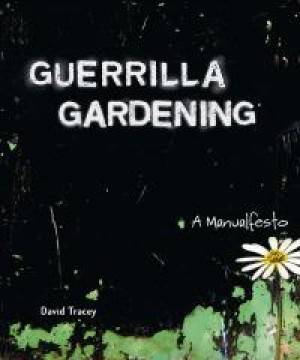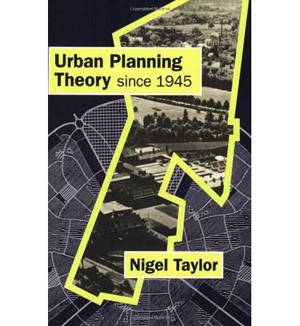Top graduate Joe Clancy shares his top book recommendations for your third year of landscape architecture. Continuing on from our first and second articles, here are 10 books that helped me through my third year of Landscape Architecture. Prices quoted are from Amazon. However, shop around, as they aren’t cheap. Of course, check your University’s library first. Keep an eye out for my follow up articles on book lists for 4th year. 10. Guerrilla Gardening: A Manualfesto (David Tracey)
The term “guerrilla” may bring to mind a small band of armed soldiers, moving in the dead of night on a stealth mission. In the case of guerrilla gardening, the soldiers are planters, the weapons are shovels, and the mission is to transform an abandoned lot into a thing of beauty. Once an environmentalist’s nonviolent direct action for inner-city renewal, this movement is spreading to all types of people in cities around the world. These modern-day Johnny Appleseeds perform random acts of gardening, often without permission. Typical targets are vacant lots, railway land, underused public squares, and back alleys. The concept is simple, whimsical, and has the cheeky appeal of being a not-quite-legal call to action. Dig in some soil, plant a few seeds, or mend a sagging fence—one good deed inspiring another, with win-win benefits all around. Get it Here! 9. Responsive Environments (Sue McGlynn, Graham Smith, Alan Alcock, Paul Murrain, Ian Bentley) This book clearly demonstrates the specific characteristics that make for comprehensible, friendly and controllable places; “Responsive Environments” – as opposed to the alienating environments often imposed today. By means of sketches and diagrams, it shows how they may be designed in to places or buildings. This is a practical book about architecture and urban design. It is most concerned with the areas of design which most frequently go wrong and impresses the idea that ideals alone are not enough. Ideals must be linked through appropriate design ideas to the fabric of the built environment itself. This book is a practical attempt to show how this can be done. Explore what is meant by the concept of a ‘responsive environment’. The illustrated step-by-step guide shows you how to achieve a ‘responsive environment’ in real-life design. Get it Here! 8. Urban Planning Theory Since 1945 (Dr. Nigel Taylor) Following the Second World War, modern systems of urban and regional planning were established in Britain and most other developed countries. In this book, Nigel Taylor describes the changes in planning thought which have taken place since then. He outlines the main theories of planning, from the traditional view of urban planning as an exercise in physical design, to the systems and rational process views of planning of the 1960s; from Marxist accounts of the role of planning in capitalist society in the 1970s, to theories about planning implementation, and more recent views of planning as a form of ‘communicative action’. Get it Here! 7. Detailing for Landscape Architects (Thomas R. Ryan, Edward Allen, Patrick J. Rand) Landscape Architectural Detailing applies the same organization to the three major concerns of the landscape architecture detailer–function, constructibility, and aesthetics. Richly illustrated, this book approaches landscape architecture detailing in a systematic manner and provides a framework for analyzing existing details and devising new ones. Landscape Architectural Detailing includes material on details related to aesthetics, water drainage and movement, structures, construction assemblies, sustainable resources, and more. Get it Here! 6 Designing with Grasses (Neil Lucas) Ornamental grasses are the ultimate success story as garden plants and tick all the boxes for today’s gardeners. As well as providing a glorious visual impact with their swaying stems and feathery seedheads, they also provide a dynamic sense of movement and calming background rustle as the wind catches their leaves. On top of all this, they are easy to care for, provide excellent wildlife habitats and are truly sustainable if you plant the right one in the right place. Get it Here! 5. Dream Plants for the Natural Garden (Henk Gerritsen, Piet Oudolf) In this book, pioneering garden designers Henk Gerritsen and Piet Oudolf describe their special choice of ideal plants – perennials, bulbs, grasses, ferns and small shrubs. An ideal plant is one that is both beautiful and robust, performing reliably with very little input from the gardener. Complete growing information is provided for each plant along with advice on how to use it to best effect. Gerritsen and Oudolf have a genuinely innovative approach to gardening. Rather than striving for big, bold masses of colourful blooms that are vigorously pruned back as soon as they have finished flowering, the authors choose plants chiefly for their form – leaves, flower heads and stems included – which means they retain their natural beauty through all the seasons. Get it Here! 4. Water Sensitive Urban Design (Jacqueline Hoyer, Wolfgang Dickhaut, Björn Weber, Lukas Kronawitter) During recent years, techniques and legislation for decentralized storm-water management have advanced all over the world. However, decentralized storm-water management systems are still under-utilized and acceptance among citizens and professionals is still lacking. Yet management of this issue will be essential for the sustainable development of cities in the future. Thus acceptance of the systems must be improved. The main question that needs to be answered is how can sustainable storm-water management be integrated with urban design in order to create safe, liveable, sustainable, and attractive cities? Get it Here! 3. Rain Gardens (Nigel Dunnett, Andy Clayden) Rain gardens encompass all possible elements that can be used to capture, channel, divert and make the most of the rain and snow that fall on a property. Using the innovative and attractive approaches described here, it is possible to enhance outdoor spaces and minimize the damaging effects of drought, storm water run-off, and other environmental challenges. Nigel Dunnett and Andy Clayden have created a comprehensive guide to water management techniques for the garden and built environment. Filled with practical, manageable solutions for small and large-scale implementations and utilizing authoritative research with state-of-the-art case studies from all over the world, “Rain Gardens” is the first book on sustainable water management schemes suitable for students and professionals. Get it Here! 2. Planting Green Roofs and Living Walls (Noel Kingsbury, Nigel Dunnett) In “Planting Green Roofs and Living Walls” the authors describe and illustrate the practical techniques required to design, implement and maintain a green roof or wall to the highest professional standards. They go on to explain how roofs may be modified to bear the weight of vegetation, discuss the different options for drainage layers and growing media, and list the plants suitable for different climates and environments. This informative, up-to-the-minute reference will captivate professionals with its illuminating new findings, and encourage gardeners everywhere to consider the enormous benefits to be gained from planting on their roofs and walls. Read our full review of Planting Green Roofs and Living Walls Get it Here! 1. Sustainable Landscape Management (Ann Marie VanDerZanden, Thomas W. Cook) The landscape industry is in the midst of major changes as the demand for environmentally responsible landscapes increases. This book offers a practical framework for the development of sustainable management strategies. Beginning with an overview of sustainable design and construction strategies, Sustainable Landscape Management focuses on key landscape management topics including ecosystem development, managing landscape beds, managing trees and shrubs, lawn care, and retro-fitting existing landscapes for sustainability, as it maps out a sound plan promoting green initiatives. Get it Here! Watch out for the next edition of Joe’s recommendations for 4th year. Article written by Joe Clancy HOME PAGE Featured image Elvert Barnes via Flickr CC 2.0 Published in BlogLogin
Lost Password
Register
If this is your first time on the new site, please click "Forgot your password?". Follow the steps to reset your password. It may be the same as your old one.















